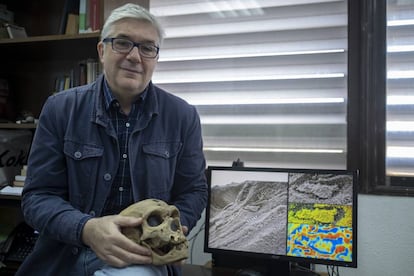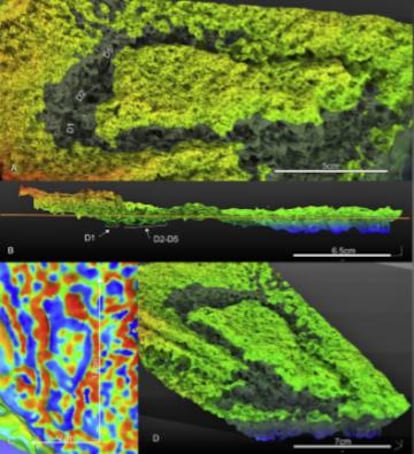New research shows Neanderthals liked to spend summer in southern Spain
A footprint found in Gibraltar not only indicates that the hominoids had found a sanctuary in the south of the Iberian peninsula, but also throws into question when they became extinct

Thirty thousand years ago, when Europe was going through an extremely cold period and snow covered everything north of the River Ebro, hominoids sought somewhere warmer that would give them a greater chance of survival.
They came to spend the summer on the south coast of the peninsula
Spanish professor Joaquín Rodríguez Vidal
The Neanderthals stumbled upon such a refuge in what is today the south of Portugal and Spain. Their most recent footprint was found in a quarry in Gibraltar, a British Overseas Territory in the south of the Iberian peninsula, and belongs to a teenager who was 1.3 meters tall. It was made 28,300 years ago, indicating that the south of the Iberian peninsula was a sanctuary for this species at that time. This has prompted a rethink of their extinction timeline, which until now has been estimated at 40,000 years ago.
“There were few family members and they came to spend the summer on the south coast of the peninsula just like [people do] today,” jokes Joaquín Rodríguez Vidal, professor of geodynamics and paleontology at the University of Huelva. Rodríguez Vidal, together with Fernando Muñiz, professor of crystallography and mineralogy from the University of Seville; Luis Miguel Cáceres, a geologist from the University of Huelva, and Carlos Neto De Carvalho, a geologist from the University of Lisbon, is leading a team which is following the traces of the last Neanderthals in the south of the Iberian Peninsula.
The footprint supporting the new theory on the survival of the Neanderthals beyond 40,000 years ago in the north of Europe is 17 centimeters long, seven centimeters wide and two centimeters deep. “The photogrammetry has provided evidence on the shape of the toes, heel, arch and the footpads,” says Muñiz. “There is no doubt that it is from a hominoid. The comparison with other footprints shows that it belongs to a Neanderthal. The thermoluminescence [OSL] gave the precise date as 28,300 years ago.”

The find in the Catalan Bay quarry on the east side of Gibraltar lends weight to an article published in 2006 in the journal Nature that questioned whether the Neanderthals became extinct 40,000 years ago. The research, found in the nearby Gorham’s Cave in Gibraltar, included stone remains dating back 24,000 years ago that were carved as the Neanderthals used to do with stone tools.
Like these remains, the footprint unearthed by the Spanish-Portuguese team adds to the growing body of evidence of Neanderthals’ presence in the region during a period in which Homo sapiens had already settled in Europe, although there is no sign of them in the Gibraltar area until 5,000 years later.
Seasonal settlements
“The Neanderthals coexisted with the Homo sapiens although they did not live together in this area,” says Rodríguez Vidal, one of the authors of the research published in the Quaternary Science Reviews. “In Gibraltar, there must have been a small group that arrived in the area by following their prey. They were seasonal settlements. They found a varied diet here and a climate that, according to the levels of pollen, was much more likely to guarantee survival.”

These characteristics made the south of the peninsula a refuge for Neanderthals and other species. As well as the homonoid footprint in the quarry, researchers have found footprints belonging to elephants, goats, bovids and felines that would also have traveled south to escape the cold. But there are no traces of Homo sapiens during this period in this particular area. This has thrown into question the theory that it was competition between the different hominoids that caused the extinction of the Neanderthals.
“There is no evidence of violence,” says Rodríguez Vidal. “The groups were very small and were forced into consanguinity which is more likely to be the cause of their extinction.”
This theory is backed by recent research carried out by a team from Eindhoven University of Technology in the Netherlands, which has been published by the journal, PLoS ONE.
“Our results indicate that the disappearance of Neanderthals might have resided in the smallness of their population(s) alone,” reads the abstract of the paper written by Krist Vaesen, Fulco Scherjon, Lia Hemerik and Alexander Verpoorte. “Even if they had been identical to modern humans in their cognitive, social and cultural traits, and even in the absence of inter-specific competition, Neanderthals faced a considerable risk of extinction.”
The Spanish-Portuguese team’s research will now focus on analyzing the traces of Neanderthals in the south of the Iberian peninsula with a view to determining their habits and behavior. The main focus will be on the caves where their remains are more likely to have been preserved. The exceptional discovery of the Neanderthal footprint and those of other animals in the quarry is due to the composition of the dune and the permanent erosion caused by the strong Levant wind, but there is still much work to be done in more protected areas.
English version by Heather Galloway.
Tu suscripción se está usando en otro dispositivo
¿Quieres añadir otro usuario a tu suscripción?
Si continúas leyendo en este dispositivo, no se podrá leer en el otro.
FlechaTu suscripción se está usando en otro dispositivo y solo puedes acceder a EL PAÍS desde un dispositivo a la vez.
Si quieres compartir tu cuenta, cambia tu suscripción a la modalidad Premium, así podrás añadir otro usuario. Cada uno accederá con su propia cuenta de email, lo que os permitirá personalizar vuestra experiencia en EL PAÍS.
¿Tienes una suscripción de empresa? Accede aquí para contratar más cuentas.
En el caso de no saber quién está usando tu cuenta, te recomendamos cambiar tu contraseña aquí.
Si decides continuar compartiendo tu cuenta, este mensaje se mostrará en tu dispositivo y en el de la otra persona que está usando tu cuenta de forma indefinida, afectando a tu experiencia de lectura. Puedes consultar aquí los términos y condiciones de la suscripción digital.
More information
Archived In
Últimas noticias
The complicated life of Francesca Albanese: A rising figure in Italy but barred from every bank by Trump’s sanctions
Half of Scotland is in the hands of 420 property owners
Reinhard Genzel, Nobel laureate in physics: ‘One-minute videos will never give you the truth’
Pinochet’s victims grapple with José Antonio Kast’s rise in Chile
Most viewed
- Pablo Escobar’s hippos: A serious environmental problem, 40 years on
- Reinhard Genzel, Nobel laureate in physics: ‘One-minute videos will never give you the truth’
- Why we lost the habit of sleeping in two segments and how that changed our sense of time
- Charles Dubouloz, mountaineering star, retires at 36 with a farewell tour inspired by Walter Bonatti
- The Florida Keys tourist paradise is besieged by immigration agents: ‘We’ve never seen anything like this’











































